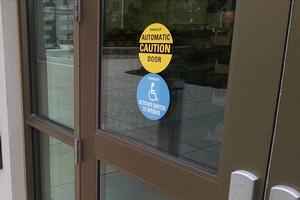Buildings
American University Working To Make Campus More Accessible

American University has long followed a tradition of inclusiveness. One area of recent focus has been to support easier and greater accessibility throughout campus for individuals with temporary or permanent physical disabilities.
While AU works to support the policies of the Americans with Disabilities Act (ADA), university administrators also welcome working together with the entire community to make further modifications and enhancements.
Earlier this year, Brian Fu, a sophomore and a member of the AU Student Government, proposed some ideas to promote greater physical accessibility throughout campus. His suggestions eventually were incorporated into the AU Undergraduate Senate Bill 16-17-024 which cited nine locations for improvement and brought them to the attention of university administrators. Since then, the Facilities department has made necessary improvements and modifications to many of the listed sites, and plans are under way for others.
Locations and modifications already completed or in the works include:
- Hurst Hall Exterior Lift – The lift was made operational. Due to safety, wear and tear concerns, and the university’s desire to limit use to individuals needing assistance, the lift is operated by key rather than push button. Keys can be obtained through the University Safety & Security Services office.
- Retail Shop Automatic Door Operators – Power-assisted door operators are being installed at as many retail shops as practicable.
- Sidewalk System to Sports Center Annex – A designated path has been installed, separate from the roadway, that directly connects the existing sidewalk from the Annex with the Asbury/Garage sidewalk.
- Access to Asbury Building – Power-assisted door operators are being installed on the two entry doors adjacent to the garage.
- Amphitheater – Two accessible seating areas that are accessible from the Tunnel area were installed at the upper level (top of the theater). Additionally, an access ramp to the upper-stage level has been installed.
- Center for Language Exploration Acquisition, and Research (CLEAR) – The Center was relocated from the inaccessible basement of Asbury to the accessible lower level of Anderson B-10.
- East Quad Building – Accessibility improvements were included in the renovation of the former first-floor lounge to house the Antiracist Research & Policy Center which, when the main entrance is made accessible, will provide full access to the Center.
- Water fountains – Existing water fountains that were inaccessible and lacked bottle-filling capability were replaced with new accessible fountains.
- Residence Hall Sidewalks and Crosswalks –Work has begun on the installation of curb cuts that would provide access to McDowell and Leonard Halls as well as connect the sidewalk between the two buildings for wheeled mobility devices.
- East Quad Building Exterior Landings – To address the lack of an accessible entrance and accessibility within the building, a study was conducted and the programmatic impacts of proposed improvements to the buildings are being evaluated currently.
- Watkins/Kreeger Access – To make the path accessible to the entrance in the lower level of Watkins, a plan has been developed to create a designated path separate from the roadway that connects directly to the existing sidewalk on the Watkins side of the parking lot – essentially, an extension of the existing sidewalk. Work will be completed in December.
- Trash removal operations also had created an obstruction to the lower-level entrance at Watkins. The Facilities Management and custodial team have since been instructed to avoid creating the obstructions.
For questions regarding the university’s work to support easier and greater accessibility throughout campus, contact David Dower, Assistant Vice President of Planning & Project Management.